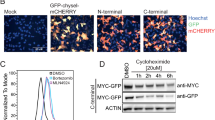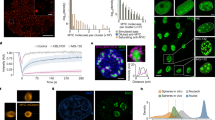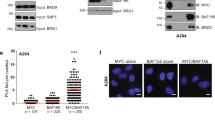Abstract
The MYC proto-oncogene encodes a transcription factor that has been implicated in the genesis of many human tumours. Here, we used a bar-code short hairpin RNA (shRNA) screen to identify multiple genes that are required for MYC function. One of these genes encodes USP28, an ubiquitin-specific protease. USP28 is required for MYC stability in human tumour cells. USP28 binds to MYC through an interaction with FBW7α, an F-box protein that is part of an SCF-type ubiquitin ligase. Therefore, it stabilizes MYC in the nucleus, but not in the nucleolus, where MYC is degraded by FBW7γ. High expression levels of USP28 are found in colon and breast carcinomas, and stabilization of MYC by USP28 is essential for tumour-cell proliferation.
This is a preview of subscription content, access via your institution
Access options
Subscribe to this journal
Receive 12 print issues and online access
$209.00 per year
only $17.42 per issue
Buy this article
- Purchase on SpringerLink
- Instant access to full article PDF
Prices may be subject to local taxes which are calculated during checkout






Similar content being viewed by others
Accession codes
References
Oster, S. K., Ho, C. S., Soucie, E. L. & Penn, L. Z. The myc oncogene: MarvelouslY Complex. Adv. Cancer Res. 84, 81–154 (2002).
Salghetti, S. E., Kim, S. Y. & Tansey, W. P. Destruction of MYC by ubiquitin-mediated proteolysis: cancer-associated and transforming mutations stabilize MYC. EMBO J. 18, 717–726 (1999).
Bahram, F., von der Lehr, N., Cetinkaya, C. & Larsson, L. G. c-MYC hot spot mutations in lymphomas result in inefficient ubiquitination and decreased proteasome-mediated turnover. Blood 95, 2104–2110 (2000).
Welcker, M. et al. The FBW7 tumor suppressor regulates glycogen synthase kinase 3 phosphorylation-dependent c-MYC protein degradation. Proc. Natl Acad. Sci. USA 101, 9085–9090 (2004).
Yada, M. et al. Phosphorylation-dependent degradation of c-MYC is mediated by the F-box protein FBW7. EMBO J. 23, 2116–2125 (2004).
Yeh, E. et al. A signalling pathway controlling c-MYC degradation that impacts oncogenic transformation of human cells. Nature Cell Biol. 6, 308–318 (2004).
Gregory, M. A. & Hann, S. R. c-MYC proteolysis by the ubiquitin-proteasome pathway: stabilization of c-MYC in Burkitt's lymphoma cells. Mol. Cell Biol. 20, 2423–2435 (2000).
Malempati, S. et al. Aberrant stabilization of c-MYC protein in some lymphoblastic leukemias. Leukemia 20, 1572–1581 (2006).
Kim, S. Y., Herbst, A., Tworkowski, K. A., Salghetti, S. E. & Tansey, W. P. Skp2 regulates myc protein stability and activity. Mol. Cell 11, 1177–1188 (2003).
von der Lehr, N. et al. The F-box protein Skp2 participates in c-MYC proteosomal degradation and acts as a cofactor for c-MYC-regulated transcription. Mol. Cell 11, 1189–1200 (2003).
Gross-Mesilaty, S. et al. Basal and human papillomavirus E6 oncoprotein-induced degradation of MYC proteins by the ubiquitin pathway. Proc. Natl Acad. Sci. USA 95, 8058–8063 (1998).
Nijman, S. M. et al. A genomic and functional inventory of deubiquitinating enzymes. Cell 123, 773–786 (2005).
Evan, G. I. et al. Induction of apoptosis in fibroblasts by c-myc protein. Cell 69, 119–128 (1992).
Littlewood, T. D., Hancock, D. C., Danielian, P. S., Parker, M. G. & Evan, G. I. A modified oestrogen receptor ligand binding domain as an improved switch for the regulation of heterologous proteins. Nucleic Acids Res. 23, 1686–1690 (1995).
Berns, K. et al. A large-scale RNAi screen in human cells identifies new components of the p53 pathway. Nature 428, 431–437 (2004).
Brummelkamp, T. R. et al. An shRNA barcode screen provides insight into cancer cell vulnerability to MDM2 inhibitors. Nature Chem. Biol. 2, 202–206 (2006).
Amati, B., Littlewood, T. D., Evan, G. I. & Land, H. The c-MYC protein induces cell cycle progression and apoptosis through dimerization with Max. EMBO J. 13, 5083–5087 (1993).
Leone, G. et al. MYC requires distinct E2F activities to induce S phase and apoptosis. Mol. Cell 8, 105–113 (2001).
Dansen, T. B., Whitfield, J., Rostker, F., Brown-Swigart, L. & Evan, G. I. Specific requirement for Bax, not Bak, in MYC-induced apoptosis and tumor suppression in vivo. J. Biol. Chem. 281, 10890–10895 (2006).
Rothermund, K. et al. c-MYC-independent restoration of multiple phenotypes by two c-MYC target genes with overlapping functions. Cancer Res. 65, 2097–2107 (2005).
Benitah, S. A., Frye, M., Glogauer, M. & Watt, F. M. Stem cell depletion through epidermal deletion of Rac1. Science 309, 933–935 (2005).
Park, Y. B. et al. Alterations in the INK4a/ARF locus and their effects on the growth of human osteosarcoma cell lines. Cancer Genet. Cytogenet. 133, 105–111 (2002).
Zhang, D., Zaugg, K., Mak, T. W. & Elledge, S. J. A role for the deubiquitinating enzyme USP28 in control of the DNA-damage response. Cell 126, 529–542 (2006).
Koepp, D. M. et al. Phosphorylation-dependent ubiquitination of cyclin E by the SCFFBW7 ubiquitin ligase. Science 294, 173–177 (2001).
Strohmaier, H. et al. Human F-box protein hCdc4 targets cyclin E for proteolysis and is mutated in a breast cancer cell line. Nature 413, 316–322 (2001).
Bhattacharya, S. et al. SKP2 associates with p130 and accelerates p130 ubiquitylation and degradation in human cells. Oncogene 22, 2443–2451 (2003).
Sutterlüty, H. et al. e45skp2 promotes p27kip1 degradation and induces S phase in quiescent cells. Nature Cell Biol. 1, 207–214 (1999).
Sorensen, C. S. et al. A conserved cyclin-binding domain determines functional interplay between anaphase-promoting complex–Cdh1 and cyclin A–Cdk2 during cell cycle progression. Mol. Cell Biol. 21, 3692–3703 (2001).
Bashir, T., Dorrello, N. V., Amador, V., Guardavaccaro, D. & Pagano, M. Control of the SCF(Skp2–Cks1) ubiquitin ligase by the APC/C(Cdh1) ubiquitin ligase. Nature 428, 190–193 (2004).
Welcker, M. et al. Multisite phosphorylation by Cdk2 and GSK3 controls cyclin E degradation. Mol. Cell 12, 381–392 (2003).
Welcker, M., Orian, A., Grim, J. A., Eisenman, R. N. & Clurman, B. E. A Nucleolar isoform of the FBW7 ubiquitin ligase regulates c-MYC and cell size. Curr. Biol. 14, 1852–1857 (2004).
Kee, Y., Lyon, N. & Huibregtse, J. M. The Rsp5 ubiquitin ligase is coupled to and antagonized by the Ubp2 deubiquitinating enzyme. EMBO J. 24, 2414–2424 (2005).
Li, M., Brooks, C. L., Kon, N. & Gu, W. A dynamic role of HAUSP in the p53–Mdm2 pathway. Mol. Cell 13, 879–886 (2004).
van Drogen, F. et al. Ubiquitylation of cyclin E requires the sequential function of SCF complexes containing distinct hCdc4 isoforms. Mol. Cell 23, 37–48 (2006).
Gomez-Roman, N., Grandori, C., Eisenman, R. N. & White, R. J. Direct activation of RNA polymerase III transcription by c-MYC. Nature 421, 290–294 (2003).
Grandori, C. et al. c-MYC binds to human ribosomal DNA and stimulates transcription of rRNA genes by RNA polymerase I. Nature Cell Biol. 7, 311–318 (2005).
Sansom, O. J. et al. MYC deletion rescues Apc deficiency in the small intestine. Nature 446, 676–679 (2007).
van de Wetering, M. et al. The β-catenin/TCF-4 complex imposes a crypt progenitor phenotype on colorectal cancer cells. Cell 111, 241–250 (2002).
Oskarsson, T. & Trumpp, A. The MYC trilogy: lord of RNA polymerases. Nature Cell Biol. 7, 215–217 (2005).
Arabi, A., Rustum, C., Hallberg, E. & Wright, A. P. Accumulation of c-MYC and proteasomes at the nucleoli of cells containing elevated c-MYC protein levels. J. Cell Sci. 116, 1707–1717 (2003).
Li, Z., Wang, D., Messing, E. M. & Wu, G. VHL protein-interacting deubiquitinating enzyme 2 deubiquitinates and stabilizes HIF-1α. EMBO Rep. 6, 373–378 (2005).
Herbst, A. et al. A conserved element in MYC that negatively regulates its proapoptotic activity. EMBO Rep. 6, 177–183 (2005).
Hemann, M. T. et al. Evasion of the p53 tumour surveillance network by tumour-derived MYC mutants. Nature 436, 807–811 (2005).
Benassi, B. et al. c-MYC phosphorylation is required for cellular response to oxidative stress. Mol. Cell 21, 509–519 (2006).
Ngo, V. N. et al. A loss-of-function RNA interference screen for molecular targets in cancer. Nature 441, 106–110 (2006).
Shachaf, C. M. et al. MYC inactivation uncovers pluripotent differentiation and tumour dormancy in hepatocellular cancer. Nature 431, 1112–1117 (2004).
Leung-Toung, R. et al. Thiol proteases: inhibitors and potential therapeutic targets. Curr. Med. Chem. 13, 547–581 (2006).
Brummelkamp, T. R., Bernards, R. & Agami, R. Stable suppression of tumorigenicity by virus-mediated RNA interference. Cancer Cell 2, 243–247 (2002).
Adhikary, S. et al. The ubiquitin ligase HectH9 regulates transcriptional activation by MYC and is essential for tumor cell proliferation. Cell 123, 409–421 (2005).
Acknowledgements
This study was supported by grants from the European Union (through the FP6 Integrated Project INTACT) to M.E. and R.B., the Deutsche Forschungsgemeinschaft (Forschergruppe Chromatin and Transregio17) to M.E. and the Netherlands Genomics Initiative/Netherlands Organisation for Scientific Research (NWO) to R.B. This work was supported by grants from the National Institutes of Health (NIH) and Cooperative Center for Medical Countermeasures Against Radiation (CMCR) to S.J.E. S.J.E. is a Howard Hughes Medical Institute Investigator. We thank D. Dobrin, B. Jebavy and R. Baumann for expert technical assistance, and M. Welcker and B. Clurman for FBW7 expression plasmids.
Author information
Authors and Affiliations
Corresponding author
Ethics declarations
Competing interests
The authors declare no competing financial interests.
Supplementary information
Supplementary Information
Supplementary Figures S1, S2, S3, S4, Supplementary Tables T1, T2, T3, Supplementary Materials Methods and Supplementary Information (PDF 771 kb)
Rights and permissions
About this article
Cite this article
Popov, N., Wanzel, M., Madiredjo, M. et al. The ubiquitin-specific protease USP28 is required for MYC stability. Nat Cell Biol 9, 765–774 (2007). https://doi.org/10.1038/ncb1601
Received:
Accepted:
Published:
Issue Date:
DOI: https://doi.org/10.1038/ncb1601



